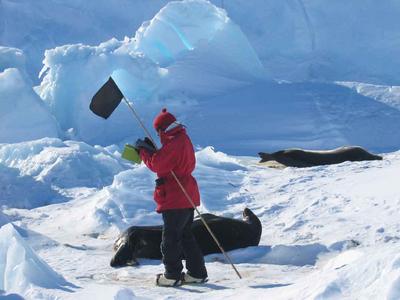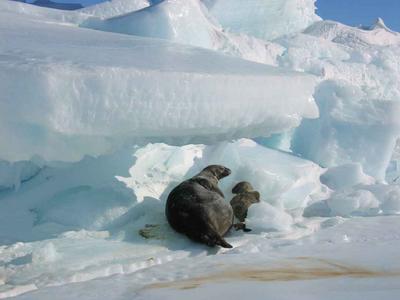
|
|
8 November, 2003
Today was census day. No, we didn't go door-to-door quizzing our
seal neighbors about their professions, income levels, or buying
habits. Instead, we spent the day visiting each of the seal colonies
in our study area and counting all the tagged and untagged seals that
we saw. This was the first of 8 censuses we will conduct over the
next few weeks to gather data about population numbers and
composition that can be analyzed to determine survivorship rates and
population demographics for the seal colonies.
The logistics of the census are straightforward. The study area was
divided into three sections: northern (Cape Evans to North Base),
southern (Pram Point to South Base), and the Delbridge Islands (Big
and Little Razorback, Inaccessible Island, and Tent Island). We
worked in teams of 2-each pair was assigned a specific section to
inventory. Our mission was to visit each colony within our section
as well as to survey the areas in-between colonies to look for errant
seals. At the colonies we checked each seal and noted its age class
(adult or pup), gender, tag number (if it was tagged), and any
relatives it had (like a mother and her pup) entering the information
into both our notebooks and our field computers. Kelly and I had the
northern section, Gillian and Mark the southern, and Darren and Brent
took the Delbridge Islands. When we do our second census next week,
one person from each pair will rotate to one of the others while the
other does a second census of the same section, so that there is some
consistency between censuses. In addition, we will change the order
in which we survey the colonies. For example, today we went in a
counterclockwise direction, starting at Cape Evans and moving south
towards North Base, next week the census will start at North Base and
work towards Cape Evans.
While counting seals may sound fairly easy, there's a little more to
the whole process. First, it is sometimes hard to read the flipper
tags on some of the older seals. The numbers may be faded, or the
tag is hidden in the flipper's folds. It then becomes a matter of
who tires first-the seal or the researcher-as you walk behind the
seal trying to lift the flipper to read the tag while the seal pulls
in the flipper and does a kind of slide/shuffle on the ice to stay
just ahead of you. So you spend a fair bit of time walking in
circles playing a game of 'follow the flipper'. In addition, some
mothers like to cover their pup's flippers when we approach to read
the tag number. When the moms are protective it also makes it hard
to hold onto the pup long enough to flip it over on its back to
figure out its sex. Then there's the tags-there are different color
tags on some of the seals. These colors fade with time, so that a
tag that was originally violet now looks kind of reddish, or ones
that were light yellow have faded to a white sort of color. We each
carry a string of tags so that we can match the colors and figure out
the proper color. Last but not least, some seals are just plain
difficult to reach or find as they may lie on the far side of a large
meltwater pool or hidden behind blocks of ice pushed up along a
pressure ridge.
By day's end, we had counted 978 seals, including all tagged and
untagged animals. We will do the next census on Wednesday. Before
then, we will be out tagging the pups and females that we saw today
who were untagged and tagging any new pups that are born before the
next census.
Daily Haiku:
Counting all the seals
Do you have a flipper tag?
Hold still while I look

Kelly enters the tag number of this seal into both her notebook and the field computer.

A mother and her pup waiting to become statistics.

You can see the flipper tags on these seals. Now I just have to get close enough to read them before they try to evade me.

Everything got counted and tagged! This rubber chicken was part of the flock that was blown off course during this week's storm.

A newly tagged rubber chicken attempts to be counted as part of a seal family.
Contact the TEA in the field at
.
If you cannot connect through your browser, copy the
TEA's e-mail address in the "To:" line of
your favorite e-mail package.
|
